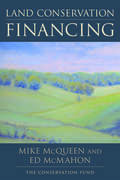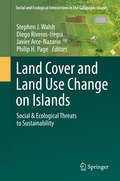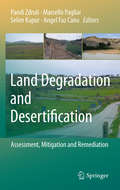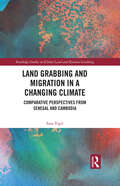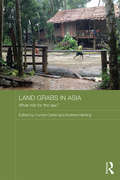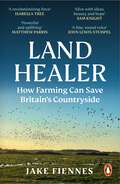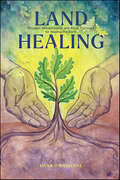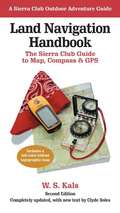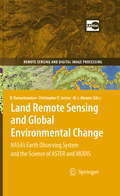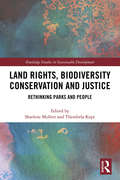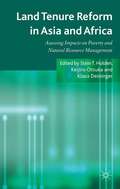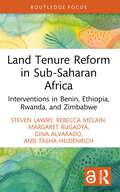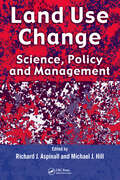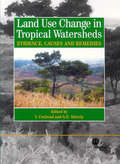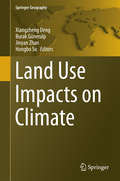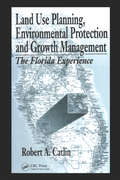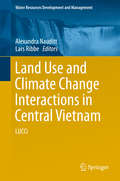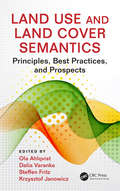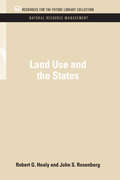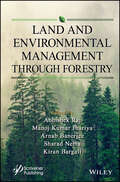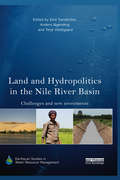- Table View
- List View
Land Conservation Financing
by Edward T. Mcmahon The Conservation Fund Mike McqueenWritten by two of the nation's leading experts on land conservation, Land Conservation Financing provides a comprehensive overview of successful land conservation programs -- how they were created, how they are funded, and what they've accomplished -- along with detailed case studies from across the United States.The authors present important new information on state-of-the-art conservation financing, showcasing programs in states that have become the nation's leaders in open-space protection: California, Colorado, Florida, Illinois, Maryland, Massachusetts, Minnesota, and New Jersey. They look at key local land protection efforts by examining model programs in DeKalb County, Georgia; Douglas County, Colorado; Jacksonville, Florida; Lake County, Illinois; Lancaster County, Pennsylvania; Marin County, California; the St. Louis metro area in Missouri and Illinois, and on Cape Cod, Massachusetts.The authors then examine how hundreds of communities have created hundreds of millions of dollars in funding by developing successful campaigns to win land conservation ballot measures. They offer case studies and pull together lessons learned as they lay out how to run a successful campaign. The authors also consider the role of private foundations, which have made immense contributions to land conservation over the past two decades.The book concludes with an examination of the emerging concept of green infrastructure -- a strategic approach to conservation that involves planning and managing a network of parks, natural areas, greenways, and working lands that can help support native species, maintain ecological processes, and contribute to the health and quality of life for America's people and its communities.Land Conservation Financing is an indispensable resource for land conservationists in the public and private sectors who are looking for a detailed, national portrait of the state of land conservation in America today.
Land Cover and Land Use Change on Islands: Social & Ecological Threats to Sustainability (Social and Ecological Interactions in the Galapagos Islands)
by Stephen J. Walsh Philip H. Page Diego Riveros-Iregui Javier Arce-NazarioGlobalization is not a new phenomenon, but it is posing new challenges to humans and natural ecosystems in the 21st century. From climate change to increasingly mobile human populations to the global economy, the relationship between humans and their environment is being modified in ways that will have long-term impacts on ecological health, biodiversity, ecosystem goods and services, population vulnerability, and sustainability. These changes and challenges are perhaps nowhere more evident than in island ecosystems. Buffeted by rising ocean temperatures, extreme weather events, sea-level rise, climate change, tourism, population migration, invasive species, and resource limitations, islands represent both the greatest vulnerability to globalization and also the greatest scientific opportunity to study the significance of global changes on ecosystem processes, human-environment interactions, conservation, environmental policy, and island sustainability.In this book, we study islands through the lens of Land Cover/Land Use Change (LCLUC) and the multi-scale and multi-thematic drivers of change. In addition to assessing the key processes that shape and re-shape island ecosystems and their land cover/land use changes, the book highlights measurement and assessment methods to characterize patterns and trajectories of change and models to examine the social-ecological drivers of change on islands. For instance, chapters report on the results of a meta-analysis to examine trends in published literature on islands, a satellite image time-series to track changes in urbanization, social surveys to support household analyses, field sampling to represent the state of resources and their limitations on islands, and dynamic systems models to link socio-economic data to LCLUC patterns. The authors report on a diversity of islands, conditions, and circumstances that affect LCLUC patterns and processes, often informed through perspectives rooted, for instance, in conservation, demography, ecology, economics, geography, policy, and sociology.
Land Degradation and Desertification: Assessment, Mitigation and Remediation
by Selim Kapur Angel Faz Cano Marcello Pagliai Pandi ZdruliLand Degradation and Desertification: Assessment, Mitigation, and Remediation reports research results in sustainable land management and land degradation status and mitigation in 36 countries around the world. It includes background papers with continental and international perspectives dealing with land degradation and desertification studies. The book assembles various topics of interest for a large audience. They include carbon sequestration and stocks, modern techniques to trace the trends of land degradation, traditional and modern approaches of resource-base conservation, soil fertility management, reforestation, rangeland rehabilitation, land use planning, GIS techniques in desertification risk cartography, participatory ecosystem management, policy analyses and possible plans for action. Various climatic domains in Africa, Asia, Europe and The Americas are covered. The book will be of interest to a variety of environmental scientists, agronomists, national and international policy makers and a number of organizations dealing with sustainable management of natural resources.
Land Grabbing and Migration in a Changing Climate: Comparative Perspectives from Senegal and Cambodia (Routledge Studies in Global Land and Resource Grabbing)
by Sara VigilThis book provides a theoretical and empirical examination of the links between environmental change, land grabbing, and migration, drawing on research conducted in Senegal and Cambodia. While the impacts of environmental change on migration and of environmental discourses on land grabs have received increased attention, the role of both environmental and migration narratives in shaping migration by modifying access to natural resources has remained under-explored. Using a variegated geopolitical ecology framework and a comparative global ethnographic approach, this book analyses the power of mainstream adaptation and security frameworks and how they impact the lives of marginalised and vulnerable communities in Senegal and Cambodia. Findings across the cases show how environmental and migration narratives, linked to adaptation and security discourses, have been deployed advertently or inadvertently to justify land capture, leading to interventions that often increase, rather than alleviate, the very pressures that they intend to address. The interrelations between these issues are inherent to the tensions that exist, in different contexts and at different times, between capital accumulation and political legitimation. The findings of the book point to the urgency for researchers and policymakers to address the structural causes, and not the symptoms, of both environmental destruction and forced migration. It shows how acting upon environmental change, land grabs, and migration in isolated or binary manners can increase, rather than alleviate, pressures on those most socio-environmentally vulnerable. This book will be of interest to students, scholars, and practitioners working on the topics of land and resource grabbing and environmental change and migration. The book will also be of interest to those analysing political ecology transitions in Africa and Asia, as well as to those interested in novel theoretical and methodological frameworks.
Land Grabs in Asia: What Role for the Law? (Routledge Contemporary Asia Series)
by Connie Carter Andrew HardingAlthough there is no universally accepted definition of the term "land grabbing", ordinary people whose livelihoods are adversely affected by land grabbing know exactly what it is. It involves the physical capture and control of land and homes, including the usurpation of the power to decide how and when these will be used and for what purposes – with little or no prior consultation or compensation to the displaced communities. This thought-provoking book defines land grabbing, and examines aspects of the land grabs phenomenon in seven Asian countries, researched and written by country-specific legal scholars. The book provides unique perspectives on how and why land grabbing is practised in China, India, Pakistan, Cambodia, Malaysia, Myanmar and Indonesia, and explores the surprising role that law plays in facilitating and legitimizing land grabs in each country. In contrast to most of the literature which law focuses on foreign investors’ rights under international law, here the focus is on domestic laws and legal infrastructures. Finding that Asian States need to move beyond existing regimes that govern land to a regime that encourages more equitable land rights allocation and protection of stakeholders’ rights, the book urges further research in the nexus between the use of law to facilitate development. Land Grabs in Asia is the first book to explore land grabbing in multiple jurisdictions in Asia. As such, it will appeal to students and scholars of law and development, law and society, and international relations, as well as being essential reading for development policy-makers and government ministers.
Land Healer: How Farming Can Save Britain’s Countryside
by Jake Fiennes'Jake Fiennes is changing the face of farming in Britain... a revolutionising force' Isabella TreeOur relationship with our land is broken: we must heal it.Jake Fiennes is on a mission to change the face of the English countryside. As Conservation Manager at Holkham in Norfolk, one of the country's largest historic country estates, his radical habitat restoration and agricultural work has nurtured its species and risen its crop yields - bringing back wetlands, hedgerows, birds and butterflies over 25,000 acres of land.But this isn't rewilding - there is no 'wild' in Britain anymore. Mass farming, crop science and industrial chemicals have destroyed the majority of our natural landscape and wildlife over the last century. Land Healer is the story of Fiennes's ambition to bring back our flora and fauna - by reclaiming our traditions and trialling new experiments which could restore our symbiosis with our land, and save our shared future.Following the farming year and the natural cycle of the seasons, Land Healer chronicles a life of conservation lived at the edges, and is a manifesto for rethinking our relationship with the natural world before it's too late.
Land Healing: Physical, Metaphysical, and Ritual Practices for Healing the Earth
by Dana O'DriscollA comprehensive guide to land healing for neopagans and Earth-based spiritual practitioners. This volume is for anyone with a desire to regenerate the natural world and heal the damage caused by humans. With the tools and information presented here, readers will be able to take up the path of the land healer with care, reverence, and respect to all beings. Land Healing covers a range of physical healing topics, such as gardening, permaculture, creating refugia, and wild tending. It also delves deeply into metaphysical healing, with ritual and chant work, energetic healing, palliative care, meditations, psychopomp work, and much more. Additionally, the book covers creating an earth healer&’s crane bag, witnessing and deep listening, and spiritual self-care. The goal of this book is to offer a wide range of physical and metaphysical tools and practices to address the challenges of the present age and bring forth a brighter tomorrow.
Land Navigation Handbook
by W. S. KalsSooner or later any outdoor enthusiast will need more than trail markers for guidance. This best-selling manual - now thoroughly revised and updated - is designed for anyone who wants to chart a course in the wilderness: hiker, backpacker, snowshoer, skier, fisherman, or hunter. Step by step, it teaches the skills that enable you to answer the vital questions: Where am I now? Which way do I head to reach my destination? How far is it? And how long will it take me to get there?Starting with the basics of interpreting maps and orienting by compass, the proceeds clearly through the more advanced mysteries of land navigation: measuring distances and estimating travel times; determining and adjusting for local declination around the globe; using an altimeter to add the dimension of height to one's position; and navigation by means of sun and stars. In updating the late W. S. Kal's text, coauthor Clyde Soles focuses on the latest developments in technology and equipment. Readers learn, for example, that through digital mapping software, one can order the exact area desired, at any scale, and print it on waterproof paper. Soles also surveys the popular handheld GPS units and instructs in their use, and provides an overview of marine navigation for the growing sport of sea kayaking. Visuals include a full-color foldout topographic map for reference and practice, plus dozens of helpful drawings and photographs.Though much has changed, one thing certainly hasn't: The new edition of Land Navigation Handbook retains the solid information, spirit, and lively humor that made it a classic among outdoorspeople everywhere.
Land Remote Sensing and Global Environmental Change
by Michael J. Abrams Christopher O. Justice Bhaskar RamachandranLand Remote Sensing and Global Environmental Change: The Science of ASTER and MODIS is an edited compendium of contributions dealing with ASTER and MODIS satellite sensors aboard NASA's Terra and Aqua platforms launched as part of the Earth Observing System fleet in 1999 and 2002 respectively. This volume is divided into six sections. The first three sections provide insights into the history, philosophy, and evolution of the EOS, ASTER and MODIS instrument designs and calibration mechanisms, and the data systems components used to manage and provide the science data and derived products. The latter three sections exclusively deal with ASTER and MODIS data products and their applications, and the future of these two classes of remotely sensed observations.
Land Rights, Biodiversity Conservation and Justice: Rethinking Parks and People (Routledge Studies in Sustainable Development)
by Sharlene Mollett Thembela KepeIn the context of sustainable development, recent land debates tend to construct two porous camps. On the one side, norms of land justice and their advocates dictate that people’s rights to tenure security are tantamount and even sometimes key to successful conservation practice. On the other hand, biodiversity protection and conservation advocates, supported by global environmental organizations and states, remain committed to conservation strategies, steeped in genetics and biological sciences, working on behalf of a "global" mandate for biodiversity and climate change mitigation. Land Rights, Biodiversity Conservation and Justice seeks to illuminate struggles for land and territory in the context of biodiversity conservation. This edited volume explores the particular ideologies, narratives and practices that are mobilized when the agendas of biodiversity conservation practice meet, clash, and blend with the demands for land and access and control of resources from people living in, and in close proximity to, parks. The book maintains that, while biodiversity conservation is an important goal in a time where climate change is a real threat to human existence, the successful and just future of biodiversity conservation is contingent upon land tenure security for local people. The original research gathered together in this volume will be of considerable interest to researchers of development studies, political ecology, land rights, and conservation.
Land Solutions for Climate Displacement (Routledge Studies in Development, Displacement and Resettlement)
by Scott LeckieThe threat of climate displacement looms large over a growing number of countries. Based on the more than six years of work by Displacement Solutions in ten climate-affected countries, academic work on displacement and climate adaptation, and the country-level efforts of civil society groups in several frontline countries, this report explores the key contention that land will be at the core of any major strategy aimed at preventing and resolving climate displacement. This innovative and timely volume coordinated and edited by the Founder of Displacement Solutions, Scott Leckie, examines a range of legal, policy and practical issues relating to the role of land in actively addressing the displacement consequences of climate change. It reveals the inevitable truth that climate displacement is already underway and being tackled in countries such as Bangladesh, Kiribati, Papua New Guinea, Solomon Islands, Tuvalu and the United States, and proposes a series of possible land solution tools that can be employed to protect the rights of people and communities everywhere should they be forced to flee the places they call home.
Land Tenure Reform in Asia and Africa
by Klaus Deininger Keijiro Otsuka Stein T. HoldenRural poverty remains widespread and persistent in South Asia and Sub-Saharan Africa. A group of leading experts critically examines the impact of land tenure reforms on poverty reduction and natural resource management in countries in Africa and Asia with highly diverse historical contexts.
Land Tenure Reform in Sub-Saharan Africa: Interventions in Benin, Ethiopia, Rwanda, and Zimbabwe (Routledge Focus on Environment and Sustainability)
by Steven Lawry Rebecca McLain Margaret Rugadya Gina Alvarado Tasha HeidenrichThis book examines the impacts of land tenure reform interventions implemented in Benin, Ethiopia, Rwanda, and Zimbabwe. Since 2000, many African countries have introduced programs aimed at providing smallholder farmers with low-cost certificates for land held under customary tenure. Yet there are many contending views and debates on the impact of these land policies and this book reveals how tenure security, agricultural productivity, and social inclusion were affected by the interventions. It analyses the results of carefully selected, authoritative studies on interventions in Benin, Ethiopia, Rwanda, and Zimbabwe and applies a realist synthesis methodology to explore the socio-political and economic contexts. Drawing on these results, the book argues that inadequate attention paid to the core characteristics of rural social systems obscures the benefits of customary tenure while overlooking the scope for reforms to reduce the gaps in social status among members of customary communities. This book will be of great interest to students and scholars of land management and use, land and property law, tenure security, agrarian studies, political economy, and sustainable development. It will also appeal to development professionals and policymakers involved in land governance and land policy in Africa.
Land Use Change and Mountain Biodiversity
by Eva M. Spehn Máximo Liberman Christian KornerPart of the worldwide biodiversity program DIVERSITAS, the Global Mountain Biodiversity Assessment (GMBA) assesses the biological richness of high-elevation biota. GMBA's focus includes the uppermost forest regions or their substitute rangeland vegetation, the treeline ecotone, and the alpine and nival belts. Providing more than description, the GM
Land Use Change: Science, Policy and Management
by Michael J. Hill Richard J. AspinallChanges in the use of land reflect a variety of environmental and social factors, necessitating an equally varied suite of data to be used for effective analysis. While remote sensing, both from satellites and air photos, provides a central resource for study, socio-economic surveys, censuses, and map sources also supply a wealth of valid informati
Land Use Changes in Tropical Watersheds: Evidence, Causes and Remedies
by G. E. Shively I. CoxheadThis book studies land use change in tropical landscapes, with particular emphasis on the economic processes that influence rates of land degradation and forest clearing. Multidisciplinary contributions draw lessons from a rich, decade-long collection of economic, social and environmental data on the Manupali upland watershed in the southern Philippines. Through this detailed case study the book documents forces leading to land use changes, in particular the potential impacts of institutional evolution and policy reforms, and highlights interrelationships between biological, economic, and social phenomena.
Land Use Impacts on Climate
by Xiangzheng Deng Jinyan Zhan Burak Güneralp Hongbo SuThis book introduces a key issue in research on the climatic impact of land cover and land use changes via terrestrial biogeophysical processes. The parameterization of surface processes and a systematic approach to modeling the climatic impacts of land use change are discussed respectively, and can be used to improve parameterization schemes for climate numerical models and to provide a systematic method, thus offering more scientific and enhanced support for research on the climatic effects of land use/cover change. Further, based on predictions and scenario analyses of land use changes in typical zones, the climatic impact of various types of changes in different areas can be simulated through climatic numerical modeling, the simulation results are suitable for use in climate mitigation, land use planning, urban development planning, etc. Thus, the book is intended for researchers and professionals working in the area of meteorology systems, climatic numerical modeling, climate change, and land use/cover change, as well as decision makers in meteorology and land use planning. Professor Xiangzheng Deng is a senior research fellow at the Institute of Geographical Sciences and Natural Resources Research, Chinese Academy of Sciences.
Land Use Planning, Environmental Protection and Growth Management: The Florida Experience
by Robert A CatlinThis book examines the history and impact of Florida's Comprehensive Planning legislation. Topics include coastal zone management, solid waste planning, land use impacts, planning strategies, and more.
Land Use Scenarios: Environmental Consequences of Development (Integrative Studies in Water Management & Land Development)
by David A. Mouat Alan W. Shearer Scott D. Bassett Michael W. Binford Craig W. Johnson Justin A. Saarinen Alan W. Gertler Julide KoracinAny alteration of the natural processes occurring on a piece of land will have expected as well as unanticipated effects, and those effects have little regard for arbitrary human boundaries. Consequently, it is not enough for land managers to consider only how they might maintain the parcels for which they are responsible; they must also anticipate
Land Use and Climate Change Interactions in Central Vietnam
by Alexandra Nauditt Lars RibbeThis book summarizes the key findings of a five-year interdisciplinary research project funded by the German Federal Ministry of Research and Education (BMBF). It serves as a typical case study for a rapidly growing and developing urban center - Da Nang City, which is surrounded by remote areas characterized by increasing migration and limited development. A number of German and Vietnamese universities and international institutions participated in the project, contributing their particular expertise to assess the data-scarce region under study, two provinces in central Vietnam with a combined area of ca. 12,000 km#65533;.
Land Use and Land Cover Semantics: Principles, Best Practices, and Prospects
by Steffen Fritz Ola Ahlqvist Krzysztof Janowicz Dalia VarankaExplore the Important Role that the Semantics of Land Use and Land Cover Plays within a Broader Environmental ContextFocused on the information semantics of land use and land cover (LULC) and providing a platform for reassessing this field, Land Use and Land Cover Semantics: Principles, Best Practices, and Prospects presents a comprehensive overview of fundamental theories and best practices for applying semantics in LULC. Developed by a team of experts bridging relevant areas related to the subject (LULC studies, ontology, semantic uncertainty, information science, and earth observation), this book encourages effective and critical uses of LULC data and considers practical contexts where LULC semantics can play a vital role.The book includes work on conceptual and technological semantic practices, including but not limited to categorization; the definition of criteria for sets and their members; metadata; documentation for data reuse; ontology logic restrictions; reasoning from text sources; and explicit semantic specifications, ontologies, vocabularies, and design patterns. It also includes use cases from applicable semantics in searches, LULC classification, spatial analysis and visualization, issues of Big Data, knowledge infrastructures and their organization, and integration of bottom-up and top-down approaches to collaboration frameworks and interdisciplinary challenges such as EarthCube. This book: Centers on the link between planning goals, objectives, and policy and land use classification systems Uses examples of maps and databases to draw attention to the problems of semantic integration of land use/cover data Discusses the principles used in a categorization Explores the origins and impacts of semantic variation using the example of land cover Examines how crowd science and human perceptions can be used to improve the quality of land cover datasets, and more Land Use and Land Cover Semantics: Principles, Best Practices, and Prospects offers an up-to-date account of land use/land cover semantics, looks into aspects of semantic data modeling, and discusses current approaches, ongoing developments, and future trends. The book provides guidance to anyone working with land use or land cover data, looking to harmonize categories, repurpose data, or otherwise develop or use LULC datasets.
Land Use and the Carbon Cycle
by Daniel G. Brown Derek T. Robinson Nancy H. F. French Bradley C. ReedAs governments and institutions work to ameliorate the effects of anthropogenic CO2 emissions on global climate, there is an increasing need to understand how land-use and land-cover change is coupled to the carbon cycle, and how land management can be used to mitigate their effects. This book brings an interdisciplinary team of fifty-eight international researchers to share their novel approaches, concepts, theories and knowledge on land use and the carbon cycle. It discusses contemporary theories and approaches combined with state-of-the-art technologies. The central theme is that land use and land management are tightly integrated with the carbon cycle and it is necessary to study these processes as a single natural-human system to improve carbon accounting and mitigate climate change. The book is an invaluable resource for advanced students, researchers, land-use planners and policy makers in natural resources, geography, forestry, agricultural science, ecology, atmospheric science and environmental economics.
Land Use and the States (RFF Natural Resource Management Set)
by Robert G. Healy John S. RosenbergAn enlarged and revised book which looks at some programs of state land use control. Focusing on the problems that have caused the public to demand such controls, on the variety of legislative responses, and on the problems of implementation that arise, this study presents a rationale for the role of the state government in the land use field. Originally published in 1979
Land and Environmental Management Through Forestry
by Manoj Kumar Jhariya Arnab Banerjee Abhishek Raj Sharad Nema and Kiran BargaliLAND AND ENVIRONMENTAL MANAGEMENT THROUGH FORESTRY Written and edited by a group of experts in the field, this groundbreaking reference work sets the standard for engineers, students, and professionals working in forestry, agriculture, ecology, and environmental science, offering the scientific community a way toward combating climate change and land degradation. This outstanding new volume covers the diverse issues of land degradation around the world and its restoration through forestry, agroforestry, and other practices. The editors have integrated many different concepts and applications into a single place from which scientists, research scholars, academicians, and policymakers can be bene???t. New insights in this area are critical, as our very existence depends on forest sustainability and land restoration management. The work consists of chapters addressing the issues of land degradation, deforestation, intensive agricultural practices, sustainable intensification, soil and forest-related services, land and environmental management, and overall sustainability of the ecosystem. The contributors address current issues and their management through a holistic and integrated approach, presenting the context of land degradation and its problem, identifying the potential areas of research in the field of land restoration, identifying the land-based services and their potential role for ecosystem sustainability, creating awareness so that future policies can be framed for the betterment of human civilization, and addressing sustainable intensification for land and environmental management and service. A standard reference work for the disciplines of forestry, agriculture, ecology, and environmental science, it will also be a way forward for combating climate change. Useful to academics, researchers, ecologists, environmentalists, students, capacity builders, and policymakers, it is a must-have for any library.
Land and Hydropolitics in the Nile River Basin: Challenges and new investments (Earthscan Studies in Water Resource Management)
by Terje Oestigaard Emil Sandstrom Anders JagerskogThe Nile River Basin supports the livelihoods of millions of people in Egypt, Ethiopia, Sudan and Uganda, principally as water for agriculture and hydropower. The resource is the focus of much contested development, not only between upstream and downstream neighbours, but also from countries outside the region. This book investigates the water, land and energy nexus in the Nile Basin. It explains how the current surge in land and energy investments, both by foreign actors as well as domestic investors, affects already strained transboundary relations in the region and how investments are intertwined within wider contexts of Nile Basin history, politics and economy. Overall, the book presents a range of perspectives, drawing on political science, international relations theory, sociology, history and political ecology.
